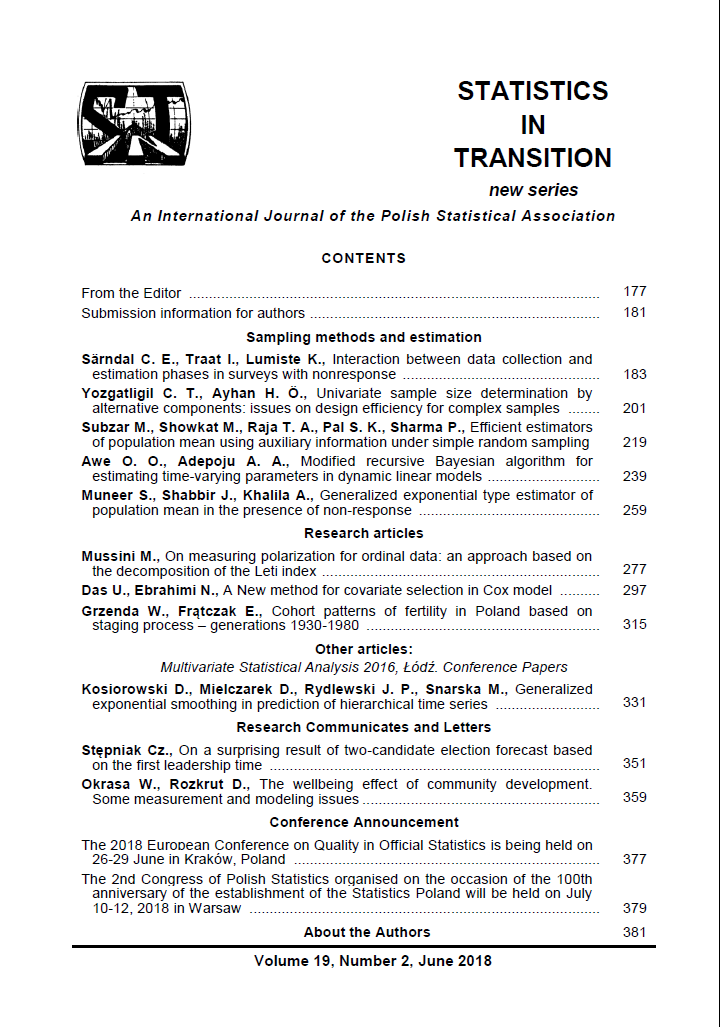ARTICLE
ABSTRACT
The two interconnected methodological tasks – measurement and modeling – become especially challenging in the context of exploration of the interaction between the local community development and individual wellbeing. In this paper, the preliminary results illustrate usefulness of an analytical framework aimed to assess an impact of the local development on individual wellbeing through multilevel modeling, accounting for spatial effects is. To this aim, a dual measurement system is employed with data from two independent sources: (i) the Local Data Bank (LDB) for calculating a multidimensional index of local deprivation (MILD), and to capture variations in geographically embedded administrative units, communes (the country's finest division), and (ii) the Time Use Survey data to construct the U-index ('unpleasant'), considered as a measure of individual wellbeing. Since one of the implications of the main hypothesis on the interaction between community development and individual wellbeing was the importance of 'place' and 'space' (effect of neighborhood and proximity), a special emphasize has been put on spatial effects, i.e. geographic clusters and spatial associations (autocorrelation, dependence The evidence that place and space matter for this relationship provides support for validity of both multilevel and spatial approaches (ideally, combined) to this type of problems
REFERENCES
ALDSTADT, J., (2010). Spatial Clustering. Chapt B.4. [in] Fischer M. M., Getis A., Handbook of Applied Spatial Analysis: Software Tools, Methods and Applications, Springer.
ALKIRE, S., (2015). The Capability Approach and Well-Being Measurement for Public Policy, Oxford Poverty & Human Development Initiative (OPHI) Working Paper, No. 94.
ANSELIN, L., SYABRI, I., KHO, Y., (2010). GeoDa: An Introduction to Spatial Data Analysis. Chap. A.4 , [in] Fischer M. M., Getis A. Handbook of Applied Spatial Analysis: Software Tools, Methods and Applications, Springer.
ARCAYA M., BREWSTER, M, ZIGLER, C M., SUBREMANIAN, S, V., Area Variations in Health, A Spatial Multilevel Modelling Approach. Health Place. 18 (4), pp. 824–831
BERNINI, C., GUIZZARDI, A., ANGELINI, G., (2013). DEA-Like Model and Common Weights Approach for the Construction of a Subjective Community Well-Being Indicator, Soc Indic Res 114.
BRADBURN, N., (1969). The Structure of Psychological Wellbeing. Aldine. Chicago.
CHAVIS, D. M., LEE, K. S., ACOSTA, J. D., (2008). Sense of Community (SCI), Lisboa, Portugal.
CAPELLO, R., Space, growth and development. Capello, R., Nijkamp, P., (eds) Handbook of Regional Growth and Development Theories. Edward Elgar, Cheltenham, UK. 2009 Clarke, Ph., Wheaton, B., 2007. Addressing Data Sparseness in Contextual Population Research Using Cluster Analysis to Create Synthetic Neighborhoods. Sociological Methods & Research, Vol. 35,No. 3, February 2007, 2007 Sage, pp. 311–351,
CORRADO, L., FINGLETON, B., (2011). Multilevel Modelling with Spatial Effects.Strathclyde Discussion Papers in Economics, No. 11–05, Department of Economics University of Strathclyde, Glasgow.
FISCHER, M. M., GETIS, A., (2010). Handbook of Applied Spatial Analysis: Software Tools, Methods and Applications. Springer.
FORREST, R., KEARNS, A, (2001). Social Cohesion, Social Capital and the Neighbourhood, Urban Stud 2001, 38, 2125.
GIBSON, J., (2016). Poverty Measurement: We Know Less than Policy Makers Realize. Asia & the Pacific Policy Studies, Vol. 3, No. 3, pp. 430–442. DOI: 10.1002/app5.141.
GOLDSTEIN, H., (2003). Multilevel Statistical Models. Edward Arnold, Loondon.
GUS (Central Statistical Office), (2015). Time Use Survey, 2013, GUS, Warszawa.
HEWES, S., BUONFI, A., ALI, R., MULGAN, G., (2010). Cohesive communities –the benefits of effective partnership working between local government and the voluntary and community sector, The Young Foundation IDeA.
HONG, G., (2015). Causality in a Social World: Moderation, Mediation and Spill over. Wiley. HOX J. J., MOERBECK, M., SCHOOT, R. van de, (2018). Multilevel Analysis: Techniques and Applications, 3rd ed., N. Y. Routledge.
KAHNEMAN, D., KRUEGER, A. B., (2006). Developments in the measurement of subjective well-being, Journal of Economic Perspectives, 20, pp. 3–24.
KALTON, G., MACKIE, CH., OKRASA, W.,(eds.), (2015). The Measurement of Subjective Well-Being in Survey Research, Statistics in Transition new series. Vol. 16, No. 3.
KIM, Y., LUDWIGS, K., (2017). Measuring Community Well-Being and Individual Well-Being for Public Policy: The Case of thr Community Well-Being Atlas" [in] Phillips, R., Wang, C., (eds.), Handbook of Community Well-Being Reseach. Springer.
KRUEGER, A. B., KAHNEMAN, D., SCHKADE, D. A., SCHWARTZ, N., STONE, A., (2009). National Time Accounting: The Currency of Life, [in:] A. B. Krueger (ed.) Measuring Subjective Well-Being of Nations: National Account of Time Use and Well-Being. University of Chicago Press. Lee, S. J., Kim, Y., Phillips, R., (eds.), Community Well-Being and Community Development. Conceptions and Applications, 2015, Springer, http://www.springer.com/978-3-319-12420-9.
LESAGE, J. P., PACE, R. K., (2010). Spatial Econometric Models, [in] Fischer M. M., Getis A., op cit.
NATIONAL RESEARCH COUNCIL, (2013). Subjective Well-Being: Measuring Happiness, Suffering, and Other Dimensions of Experience. Panel on Measuring Subjective Well-Being in a Policy-Relevant Framework. A. A. Stone and C. Mackie (eds.), Committee on National Statistics, Division of Behavioral and Social Sciences and Education, Washington, DC: The National Academies Press.
OECD, (2015). Better Life Index, OECD Publishing. Paris.
OECD, (2013). OECD Guidelines on Measuring Subjective Well-being, OECD Publishing.
OKRASA, W., (2017). Community Wellbeing, Spatial Cohesion and Individual Wellbeing – towards a multilevel spatially integrated framework, [in] W. Okrasa (ed.) Quality of Life and Spatial Cohesion: Development and Wellbeing in the Local Context. Cardinal Stefan Wyszynski University Press. Warsaw.
OKRASA, W., (2013). Spatial Aspects of Community Wellbeing. Analyzing Contextual and Individual Sources of Variation using Multilevel Modeling. Paper at th 59th World Statistics Congress, Hong Kong, August, pp. 25–30.
RAO, J. N. K., MOLINA, I., (2015). Small Area Estimation, 2 nd ed., Wiley, Hoboken, New Jersey.
ROZKRUT, D., ROZKRUT, M., (2006). Analysis of the economic development of districts in Poland as a basis for the framing of regional policies. [in]: Spiliopoulou, M.; Kruse, R.; Borgelt, C.; Nürnberger, A.; Gaul, W. (eds.), From Data and Information Analysis to Knowledge Engineering – Studies in Classification, Data Analysis, and Knowledge Organization, Springer, Berlin 2006, pp. 518–525.
STIGLITZ, J., SEN, A., FITTOUSSI, J-P., (2010). Measuring our lives. New York.: The New Press.
SUBRAMANIAN, S. V., (2010). Multilevel Modeling [in] Fischer M. M., Getis A., Handbook of Applied Spatial Analysis: Software Tools, Methods and Applications, Springer
